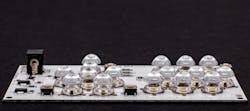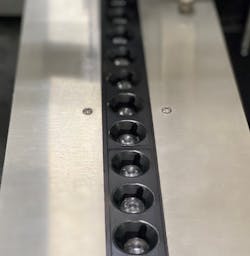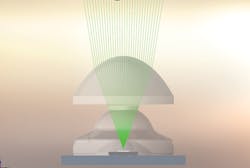Surface-mount optics offer simpler optical assembly manufacturing
Surface-mount optics (SMOs) are a relatively new concept in the lighting industry. This technology uses silicone optics placed directly on a PCB and allows for continuation through the solder reflow oven. Because silicone can withstand solder reflow temperatures while maintaining its optical performance, there is no need for a post-reflow assembly step. No holders, fasteners, or glue are necessary, either. Most secondary optical component materials for LEDs cannot withstand solder reflow temperatures (usually more than 250°C)—they may crack, slump, or melt, causing a degradation of optical and mechanical properties, as well as low transmission or other limitations in optical performance.
Optical silicones have been around since the 1950s, with the primary application being an encapsulant for LEDs on boards or wafers. However, silicone has more material and design advantages to serve automotive, medical, industrial, consumer, and other mid- to high-volume markets with improved optical performance and lower assembly costs. Dow produces various grades of optical silicone material for multiple applications; its primary moldable optical silicone materials are either clear with high transmission or white with high reflectance.
Silicone is also known as polydimethylsiloxane and, inherent in the material chemistry, the siloxane bond (Si-O) has higher energy than the carbon and oxygen bond (C-O) in epoxies and thermoplastics. This bond energy gives silicone better thermal and UV stability.
There are many other properties that make silicone an excellent material choice in challenging environments. Some of these material advantages include:
Environmental. Stability in UV, humidity and temperature extremes; creates moisture seals; non-yellowing; scratch- and impact-resistant.
Mechanical. Vibration damping; tunable modulus; flexible for demolding.
Optical. High optical transmission from UVA and UVB through the visible spectrum, into the SWIR wavebands.
Design. Design flexibility enables complex geometries and replicates microstructures, including holographic or diffractive optics.
Additional features and benefits include light weight; low density (specific gravity of 1.07), easy to clean, and disposable as a front-surface optic. Material modifications are also possible with silicone, as it can be tuned for specific properties in highly technical applications. In general, optical silicones outperform many other materials for applications in harsh environments.
Beyond glass and thermoplastics
Molded optics with negative draft angles or undercuts are enabling the utilization of silicone. Rigid materials in general do not have that capability. The classic Fresnel lens has prismatic facets that have both an optical curve and a near-vertical surface. This structure has served the optics industry for centuries and has extended into diffractive optics. Typically, the near-vertical surface slopes away from the facet with a positive angle for manufacturability. In lighting applications, there are situations where an undercut or negative draft enhances the performance of the optic or allows the integration of mechanical features.
Enabling the design engineer to include geometries such as an undercut or negative draft condition is a unique advantage of using silicone. Moldable optical silicone can stretch and flex out of the mold, enabling the integration of multiple unique surfaces in a compound optical assembly and single-shot molding of these assemblies. Eliminating the element-to-element alignment in the final system can further reduce assembly costs.
Silicone has its limitations, however. The low surface energy—while great for cleaning—also means almost nothing sticks to it, including antireflective coatings. Though generally not a problem for illumination applications, a design should consider Fresnel losses, as secondary coating options are limited. In addition, there are limited adhesives available to mount silicone optics. Due to its flexibility, optics produced in silicone may need strength-enhancing ribs or mounting features to clip into a housing, instead of conventional mounting methods.
Interestingly, this same flexibility allows silicone parts to incorporate O-ring seals for moisture sealing, self-alignment, and mechanical attachment. For example, a silicone end cap for an optical assembly, or an optical assembly snapped on to the distal tip of a medical probe, would be both optical and final protective surfaces. These features, along with its cost-effectiveness, make moldable optical silicone ideal as a disposable, final surface optic. It can also extend the product lifetime by eliminating the chance of chipping or scratching a glass optic.
The true value of silicone optics extends well beyond the material and optical properties. Its wide variety of features and flexibility can streamline the optical assembly process by simplifying and eliminating process steps. In addition, the time and cost savings in manufacturing can advance adoption in mass markets with a lower total cost per product. These advantages need consideration in the product design stage. They should include discussions with designers, product managers, packaging engineers, and others involved in the product’s assembly and packaging. Failure to incorporate features at a system level is a costly mistake and can lead to expensive redesigns in the future.
Reducing assembly costs with SMOs
One of the original methods of incorporating optics onto a PCB was adding an assembly step after the SMT reflow process. This process step could require manually loading the PCB assembly into pick-and-place assembly equipment, or manually placing the optics on the PCB, followed by dispensing adhesive, curing, and optical performance testing.
SMO technology was created to eliminate this post-reflow assembly step, increasing placement accuracy and reducing the number of potential failure points and overall cost (see Fig. 1).
The molded optics are mounted in a metal solder ring and soldered in place simultaneously with the SMT electronics; this produces significant total cost savings. The alignment tolerance is dependent on the optical design and assembly equipment. Manufacturing accuracy with state-of-the-art equipment can be as good as tens of microns, which is much better than industry norms. SMOs are available in tape-and-reel packaging and are compatible with standard pick-and-place equipment (see Fig. 2).Silicone SMOs: Solutions to production challenges
The depth and breadth of optical silicone and SMOs are extensive. Overall, silicone SMOs have material, design, assembly, and application advantages in challenging environments, and are cost-competitive with traditional rigid thermoplastics. This diversity supports applications in automotive, medical, industrial, commercial, and several other markets.
SMO cost benefits extend far beyond replacing more expensive glass or thermoplastic parts and assemblies. Integrating multiple components in a single SMO with alignment features and streamlining assembly processes will reduce the overall product cost. Potential cost savings span the entire optomechanical space, especially in environments where other optical materials cannot perform well.
About the Author
Greg Sharp
Applications Engineer, LumenFlow
Greg Sharp has a B.S. in Chemical Engineering and graduate work in Applied Optics (MBA 2021). His background is in photolithographic production of micro-optics, high-energy laser analysis, lidar, and novel technologies and applications in optics. He is an applications engineer with LumenFlow (Zeeland, MI).
Harold Brunt
Optical Engineer, LumenFlow
Harold Brunt is an optical engineer at LumenFlow (Zeeland, MI), specializing in the design, manufacturing, and product development of LED applications using ANSYS SPEOS with SpaceClaim, and SolidWorks. His background is in mechanical and optomechanical engineering in aerospace, precision instruments, and consumer products, and he holds 11 patents.
Nick Mustola
Optomechanical Design Engineer, LumenFlow
Nick Mustola has a B.S. in Mechanical Engineering and works with LumenFlow (Zeeland, MI) as an optomechanical design engineer with a focus on lighting and illumination systems. His background is in manufacturing and product design in multiple industries including automotive, furniture, and lighting.



